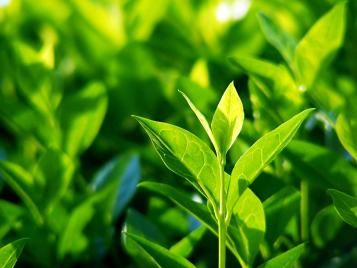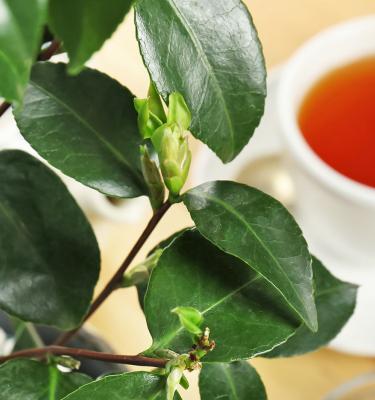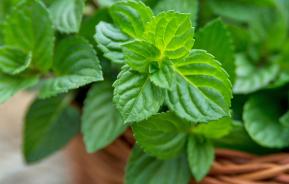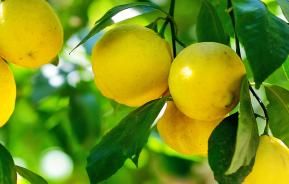If you are British there is (arguably) nothing more comforting, relaxing or social than sitting down and having a nice cup of tea. Something magical happens in the process of warming a pot and letting the leaves steep for three and a half minutes. If you are one of those who drinks between 3-5 cups a day, why not have a go at growing your own tea? Can you really grow tea in the UK though?
Growing tea in the UK may not be as crazy as you might think, as its origins are in the chilly foothills of the Himalayas. Today there are tea plantations in the Scottish highlands and on the rugged moorlands of Cornwall. Here’s our guide on How to Grow Tea.
The tea plant, Camellia sinensis
Whilst there are many different types of tea available on the supermarket shelf, most originate from the ‘Tea Plant’, otherwise known as Camellia Sinensis variant Sinensis.
Camellia sinensis is a hardy evergreen plant boasting glossy green, pointed and fragrant leaves. The appearance of delicate white flowers in the autumn means that this shrub has more to offer than just a refreshing cuppa. If you can grow other varieties of Camellia in your garden chances are you’ll be able to grow Camellia sinensis.

Tea plant growing conditions
Camellia sinensis likes an ericaceous soil in a bright, sheltered position but with partial shade. The soil should be free draining and so planting in pots is a great option giving even the smallest of gardens the chance to become a domestic tea plantation.
Tea plants can grow to around 2 metres tall. When planting more than one sapling in the ground, leave a distance of 1.5 metres between the plants. This will give room for the plants to breathe and for them to become bushy.
Growing tea from seed
Growing tea from seed is not an exact science and with a germination time of up to 8 weeks, it’s not the fastest way to host your first tea party! However, if you fancy giving it a whirl, buy your tea seeds from a reputable trader and ensure that the variety supplied is the Chinese Camellia Sinensis Sinensis and not the Indian Camellie Sinensis Assamica, which needs tropical conditions to thrive.
Propagation of tea seeds
First, soak your tea seeds in water for between 24 and 48 hours. This allows the seeds to absorb as much water as it can and help to kick start the germination process. In general the seeds that sink give the highest chances of successful germination, although this is by no means guaranteed.
Once removed from the water, place in a seed tray in a warm, sunny position and spray to keep damp. Allow the seeds to come back to air temperature and then cover over with an inch of coarse vermiculite.
Germination
Keep the soil moist and in a warm, sunny position, hopefully, germination will occur 6-8 weeks later. Once germination of your tea seeds has occurred and the plants have developed 3 or 4 leaves, it is time to separate them into pots using ericaceous compost.
Move to a warm, but partially shaded position, spray regularly to keep the soil moist but not wet.
Cultivating tea plants
When the plant reaches about 20cm you can start hardening the plant off. Re-pot, giving the roots plenty of space for growth, continue to use ericaceous compost and make sure you add in good drainage, as tea plants like a lot of water but also need any excess to drain away to stop root rot. Place in a sheltered and partially shaded spot in the garden or on the patio, under the shadow of a small tree or large shrub.
Tea plants need protecting from frost when young and it is advisable to bring them into a greenhouse or cool porch during the first two winters.
Camellia sinensis takes 3 years to reach maturity but once the shrubs reach around 1m in height, they should be hardy enough to survive an English winter.
Tea plants don’t really need a feed, just plenty of water, but if you do need to give them a feed, use an ericaceous food and do not harvest that plant for 12-20 days after the next flush, as the taste of the feed will come through the tea leaves.
Harvesting tea plants
Tea plants are generally dormant in Winter months. So Spring should bring evidence of new growth in the first ‘flush’ of tea shoots. Pluck the first two bright green leaves and the bud from each branch using finger and thumb, this should be easy to do with a gentle pluck. Regular harvesting like this encourages further growth and helps to create a more bushy shrub. These young, apple green leaves are then ready to be brewed into a calming cup of tea.
Harvesting of the tea plant can occur several times throughout the more vigorous growing period of spring to summer, and this gives plenty of opportunity to try different methods of creating your preferred tea. The same plant, Camellia sinensis, gives rise to several different teas: Green Tea, Oolong Tea and Black Tea. The difference between them is down to the processes the leaves undergo once harvested.

Processing tea leaves
Turning your home grown harvested tea leaves into a lovely cup of tea only takes a few steps, have a look at the tea production process.
How to grow tea kits
If you want to take some of the gamble out of growing tea from seed you can purchase tea growing kits from a variety of sources. These kits come with grow pellets, tea seeds and full instructions for successful germination and growth.
You are also able to grow your own tea by purchasing Camellia sinensis saplings.
The Wee Tea Company love all things tea, especially their home grown tea cultivated and manufactured in Scotland! You can find The Wee Tea Company served and sold in the best cafes, delis, farm shops and restaurants in the UK.
Top 10 tea facts
- If it’s not from the Camellia sinensis plant – it is not strictly speaking tea! Nowadays a lot of what is called TEA is actually blends of flowers and herbs – herbal infusions to be accurate.
- Although there are some 2000 or so varieties of tea, it is not the plant that differs, but the way it is grown, where it is grown and what happens to it after the leaves have been picked.
- Tea if often treated to alter and create new flavours. Popular treatments include spraying with oil, smoking and adding flowers to the blend.
- It is thought tea was discovered by accident in China as an Emperor allowed some leaves to remain in a pot of boiling water – which in turn created the brew! And that was over 2000 years ago!
- The average person in the United Kingdom drinks as much tea as 23 Italians.
- 40% of all fluid drunk in Britain every day is tea.
- After a 5 year study it was found that volunteers who drank 375ml of black tea per day had a 43% reduction in the risk of having a heart attack and a 70% reduced risk of having a fatal heart attack.
- As a nation we enjoy drinking tea on a daily basis, getting through 165 million cups a day.
- The main tea growing regions of the world are India, Sri Lanka, China, Japan, Taiwan and Africa.
- Some climatologists believe that as a result of climate change, one day the Scottish Highlands will be the ideal place to grow and harvest tea.
Have you ever been able to grow your own tea? Do you have some hints and tips to share? Please let us know at our social media channels!








